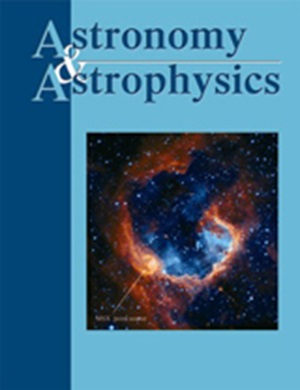CARMENES 搜寻 M 矮星周围的系外行星
IF 5.8
2区 物理与天体物理
引用次数: 0
摘要
真空波长为 10 833 Å 的 He I 红外(IR)线是研究恒星大气层和环绕恒星运行的行星的诊断指标。我们首次研究了一组 M-矮星色球层模型中 He I 红外谱线的行为,M-矮星的色球层密度要高得多,这可能有利于水平种群的碰撞,而不是光离子化和重组,而光离子化和重组被认为在太阳型恒星中占主导地位。为此,我们使用了已发表的针对光谱类型为 M2 V 和 M3 V 的恒星的 PHOENIX 模型,并根据为太阳情况开发的公式计算了一系列具有不同活动水平的新模型。我们对这些模型中 He I 红外谱线的行为进行了详细分析。我们评估了该线与其他色球层线的关系,以及极紫外辐射场的影响。对 He I 红外谱线强度与各自的极紫外辐射场强度的函数关系的分析表明,在不活跃的模型中,光离子化和重组是形成谱线的必要机制,而在最活跃的模型中,碰撞开始发挥作用。此外,已发表的模型集在 Na I D2、Hα 和最蓝的 Ca II 红外三重线的范围内进行了优化,可以充分预测恒星样本中大多数恒星的 He I 红外线。尤其是那些最不活跃、He I 红外谱线最弱的恒星,我们的模型对它们的拟合效果最差,看来我们关于单一不活跃成分的填充因子为 100%的假设对这些恒星不再适用了。本文章由计算机程序翻译,如有差异,请以英文原文为准。
The CARMENES search for exoplanets around M dwarfs
The He I infrared (IR) line at a vacuum wavelength of 10 833 Å is a diagnostic for the investigation of atmospheres of stars and planets orbiting them. For the first time, we study the behavior of the He I IR line in a set of chromospheric models for M-dwarf stars, whose much denser chromospheres may favor collisions for the level population over photoionization and recombination, which are believed to be dominant in solar-type stars. For this purpose, we use published PHOENIX models for stars of spectral types M2 V and M3 V and also compute new series of models with different levels of activity following an ansatz developed for the case of the Sun. We perform a detailed analysis of the behavior of the He I IR line within these models. We evaluate the line in relation to other chromospheric lines and also the influence of the extreme ultraviolet (EUV) radiation field. The analysis of the He I IR line strengths as a function of the respective EUV radiation field strengths suggests that the mechanism of photoionization and recombination is necessary to form the line for inactive models, while collisions start to play a role in our most active models. Moreover, the published model set, which is optimized in the ranges of the Na I D2, Hα, and the bluest Ca II IR triplet line, gives an adequate prediction of the He I IR line for most stars of the stellar sample. Because especially the most inactive stars with weak He I IR lines are fit worst by our models, it seems that our assumption of a 100% filling factor of a single inactive component no longer holds for these stars.
求助全文
通过发布文献求助,成功后即可免费获取论文全文。
去求助
来源期刊

Astronomy & Astrophysics
ASTRONOMY & ASTROPHYSICS-
自引率
27.70%
发文量
0
期刊介绍:
Astronomy & Astrophysics is an international Journal that publishes papers on all aspects of astronomy and astrophysics (theoretical, observational, and instrumental) independently of the techniques used to obtain the results.
 求助内容:
求助内容: 应助结果提醒方式:
应助结果提醒方式:


